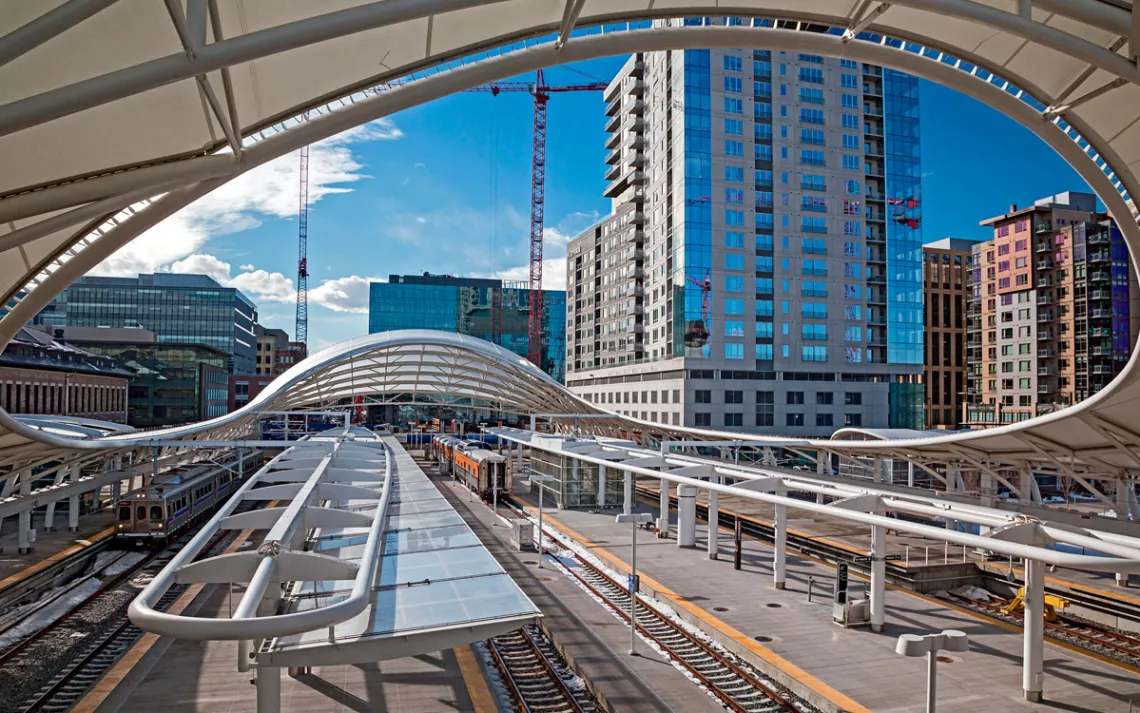Pro-Housing Urban Millennials Say "Yes In My Backyard"
Housing—dense, near transit, and green—can be a climate solution

Denver is one of many cities pursuing sustainable development. | Photo by Jim West/Alamy Stock Photo
WHEN PRESIDENT DONALD J. TRUMP announced he was withdrawing the United States from the Paris climate accord, he framed it as a stark choice: "I was elected to represent the citizens of Pittsburgh, not Paris," he declared.
The mayors of those cities don't see it that way. In a joint op-ed in the New York Times, Paris mayor Anne Hidalgo and Pittsburgh mayor Bill Peduto declared their unity in the fight against climate change—and talked about how it was improving both cities. "The experience of Pittsburgh in the three decades since the collapse of the steel industry reveals how a commitment to science, research, and green technology can transform our cities," they wrote.
Pittsburgh, it turns out, is in the midst of a year-over-year burst of economic activity—its per-capita GDP in 2016 grew at almost twice the pace of the nation's, thanks to a thriving tech sector. Its planners are working on the city's third climate action plan (the first was published in June 2008), outlining specific steps it will take to cut greenhouse gas emissions.
Pittsburgh and other cities are taking a leading role in the fight against global warming—and growth and prosperity are part of the plan. Standard efforts include negotiating with local utilities to switch to renewable energy and beefing up green infrastructure like mass transit. In addition, a new movement, composed largely of millennials, is pushing hard on city leaders to make their cities denser and more walkable and bikeable, with green infill development, more affordable housing, and transit-oriented centers. In a twist on the popular label of those skeptical of urban development, these new activists proudly adopt the mantle of YIMBY—"Yes In My Backyard."
"Housing is an environmental issue," says Laura Bernstein, a volunteer with the Seattle Group of the Sierra Club and a YIMBY advocate. "Suburbanization and poverty are climate-justice issues. How do you do equitable development, and how do you look to groups that are most impacted by growth in a way that is also addressing the primacy of the automobile?"
Studies have established a clear correlation between urban density and reduced carbon emissions. A 2014 report from the University of California, Berkeley, analyzed population density in more than 30,000 zip codes in all 50 states along with 37 variables, including household income, transportation, and census data. It found that families living in denser urban cores had a carbon footprint that was half that of families living in suburbs.
But density by itself doesn't necessarily reduce carbon emissions. The key factor, says Daniel Kammen, professor of energy at UC Berkeley and one of the study's principal investigators, is the relationship between urban density and smart growth. "We found that if you integrate living and work and services, you benefit hugely by smart densification," he says. "But if you have huge high-rise blocks that are totally disconnected from shopping and downtown services, then you don't benefit much at all."
YIMBYs want more than just interconnected neighborhoods—they also want housing to be affordable. According to a 2017 report from the National Low Income Housing Coalition, in every state, housing costs are now too high for most low-wage earners. More housing, combined with affordability policies, can counteract skyrocketing prices.
In Denver, an effort has been under way since the 1990s to prioritize high-density and mixed-use urban areas, including a rail transit system to connect them. And in 2016, the Denver City Council approved its first-ever dedicated affordable-housing fund, with the goal of raising $150 million over 10 years. It's a start, but it's not nearly enough to get to the level of affordable housing stock the city needs.
"If you can create a land-use configuration that will encourage people to take transit more often, to bike, and to walk, you're really making an improvement as far as reducing congestion, reducing vehicle emissions, and reducing energy use," says Andrew Goetz, a professor of geography and the environment at the University of Denver.
Such policies can lead to tension with those residents—often older, whiter, and more affluent—who don't want the traffic, congestion, and other effects of urban density, such as shadows from high-rise buildings. The conflicts play out before zoning boards, city councils, and other public bodies where young YIMBYs turn out to support large housing projects. The NIMBYs who oppose them are often progressive, environmentally minded individuals who believe in climate action and recognize that sprawl is unsustainable; they just want to preserve the look and feel of the neighborhoods they call home.
So how do you convert a NIMBY into a YIMBY?
Bernstein points to Seattle's Equity and Environment Agenda as an example of how to invite both sides to the conversation. The initiative sought to bring together historically white-led groups and communities of color and led them through a process to develop a set of commitments around equitable development and density. Seattle also has in place what it calls a "housing affordability and livability agenda," intended to address what Mayor Ed Murray has called "our worst housing-affordability crisis in decades."
Following Trump's withdrawal from the Paris accord, more than 330 "climate mayors" representing 65 million Americans declared, "We are still in." Making their cities more dense, connected, and affordable will help them fulfill that pledge.
"This isn't about my backyard," says Bernstein. "It's about all of our backyards, and how we are going to sacrifice and be innovative together."
This article appeared in the September/October 2017 edition with the headline "Getting to YIMBY."
 The Magazine of The Sierra Club
The Magazine of The Sierra Club



